I’ve been sewing masks this week, as many of you have, and it got me to thinking about my days of garment sewing (BQ—before quilting). I didn’t learn quilting from my mother or gran, but I did make a lot of clothes in high school and the early years of my marriage. And no, I’m not sharing a photo of my home-made prom dress, but I will say that the sprigged voile sleeves were difficult.
I wonder how many current quilters followed the same route, from garments to quilts?
Someone who did was Hall of Fame honoree Virginia Avery. But Jinny, as she was known, took it to a whole new level and pioneered what we now call “wearable art”. She taught herself to sew clothes– without a pattern– at age twelve, and then, when the Bicentennial quilt craze came along, she started teaching others to quilt, even though she herself wasn’t really a quilter. This can-do attitude carried her through life, and maybe explains why she wore a signature rhinestone pin that spelled, “It’s OK”. Words to live by these days.
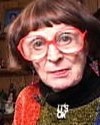
Avery seemed to love not only rhinestones, but all things flashy and improvisational. Her quilted jackets were made in sumptuous fabrics like Thai silk, African cotton and gold moiré. One jacket, a tribute to New York City, had subway tokens stitched into it.
It’s hard to imagine in these quarantine times having a place to wear fancy garments, but it’s still nice to dream. Or think about taking your socially-distance walk wearing this cape that Avery made.
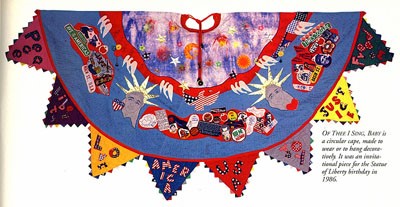
This is “Of Thee I Sing Baby”, a circular cape made as an invitational piece for the birthday of the Statue of Liberty, sponsored by the Museum of American Folk Art in New York City, 1986 – from March 1998 issue of Quilters Newsletter Magazine.
These book covers, from the Hall of Fame library or available on Amazon and sometimes e-Bay, give you another taste of Avery’s fashion flair. She wrote three other books, all of them “outside the box”.
How did she come to be so creative? “We are all surrounded by designs every day of our lives,” is her answer to where her inspiration came from. “We just have to learn to open our eyes and see.” The coat on the cover of Wonderful Wearables was inspired by Avery’s own life. I won’t say what the connection was in this post; you can read more , and see her modeling the piano coat here: https://quiltershalloffame.net/virginia-avery/ .
So, my takeaway from Virginia Avery is that I can use this externally-imposed and internally-accepted quiet time to open my eyes. I don’t see myself ever going totally free-form, but maybe I’ll find an architectural detail that will become a shape for a quilt block. But even if all I see is a different way to look at color combinations, “It’s OK”.
And I’ll close with a picture of my own wearable art, Covid-19 style. Look close, it has horses (because as we learned from Dr. Dunton in last week’s post, and we saw with Virginia Avery, you should have more than one hobby.) Stay well, and be creative!
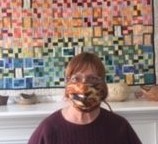
Your quilting friend,
Anna

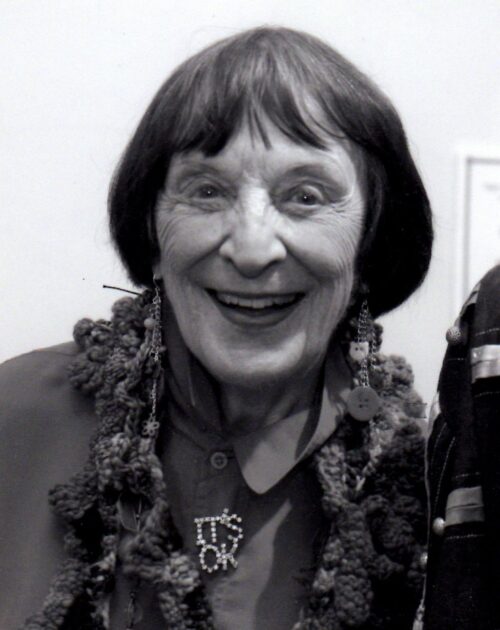

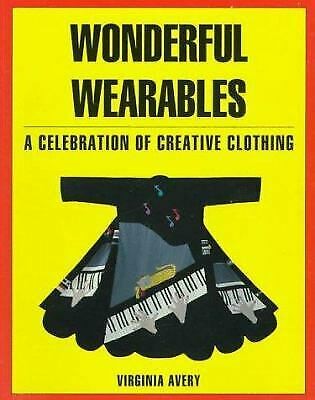
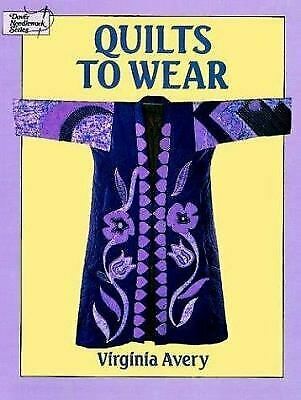
I love this story. I’m going to bring out all those circa 1950’s rhinestone pins and earrings my mother in law gave me years ago. Jinny is truly an artist!
I went from sewing pillows and curtains as a young homemaker to sewing maternity clothes, to sewing crafty decorating items to Cross Stitch. And then….I went to a local quilt show and that ended everything else.
Thanks for sharing this story with us.
Annabelle, when you make something with those earrings, please send me a picture!
I too was a garment sewer at a young age. Early in my married life, while living in NOLA< I took a quilting class with a friend. We made a sampler, using cardboard templates, all sewn by hand. It surely taught me a lot about quilt piecing. In that same quilt shop were some pre-pleated kits for making hand smocked ornaments. In time, as the mother of two girls, I became an English smocking fiend! After the girls outgrew mom made clothing- except for prom and wedding dresses, I stepped up on the quilting hobby. I'm so happy to have this hobby/lifestyle (as some call it) because of the joy it brings as a creative person, and because of all the wonderful people I now call friends. Thanks Anna for your contributions!
Chris, I’m so happy to call you a quilting friend. Please come back and read more; I’ll be posting every week.